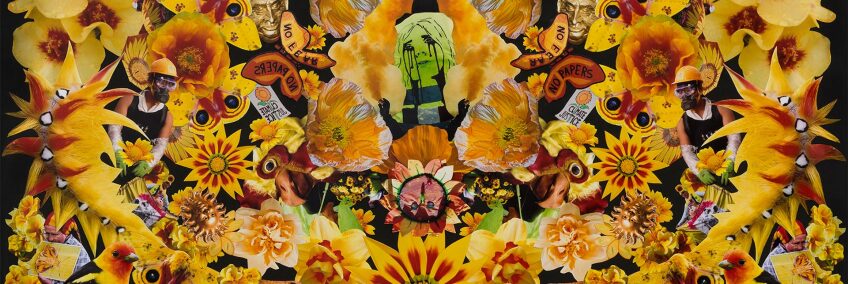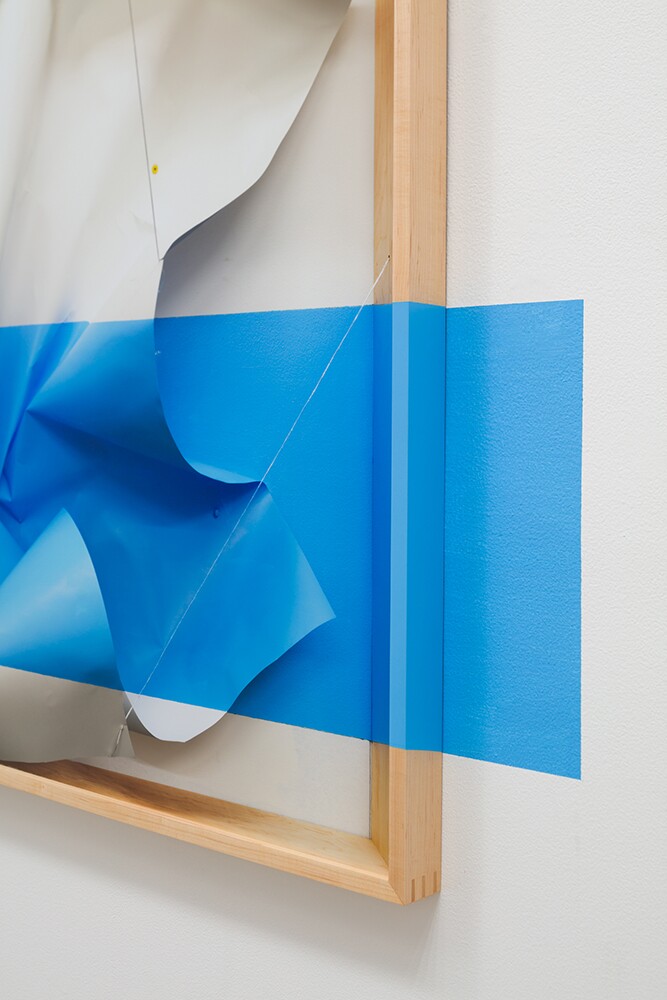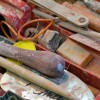Forced to Close Their Doors, Art Galleries Embrace Online Exhibitions

When Los Angeles announced its “safer-at-home” restrictions on March 19, many of the city’s art galleries scrambled to figure out how to stay in business. Most had websites where they displayed pictures of artwork and promoted exhibitions, but art dealing has always been very much an in-person endeavor. Buyers want to actually see an artwork before they invest, and relationships between dealers, collectors and curators are cemented by face-to-face interactions at openings, art fairs and galas.
In response to the closure of their physical spaces, L.A. art galleries have embraced online exhibitions to an unprecedented degree. This transition has changed the way they present artworks and, unexpectedly, how they relate to one another.
For Luis De Jesus of the eponymous gallery on South La Cienega Boulevard, moving online has been an expansion rather than a limitation. When lockdown began, his staff was already redesigning the gallery’s website, so they added an “online viewing room.” “It’s like the second gallery that we don’t have,” De Jesus said, “It functions like an alternative space, a project space, and that to me is very exciting.”

The gallery has presented artworks paired with experimental texts by local writers and featured images from museum shows that closed due to the COVID crisis. It will also give artists free rein to experiment. “We’ve told them, you are free to use it as you wish. This is a playroom for you. There are no rules here whatsoever,” said De Jesus.
In Koreatown, Commonwealth and Council has taken a slightly different approach. “We didn’t want to occupy the online space with existing work that is already photographed that is not intended for online,” said founder Young Chung. “If we do continue to use the online platform, we would love to put together original content.” So far, the gallery has used the “Together” page of its website to present video works and footage of pre-lockdown events, as well as recipes and at-home exercise instructions created by artists.

Chung also acknowledged that artists may not be as productive right now. “A lot of them are engaged in civic duties, and they’re like, ‘I’m not making any work. It’s not about me right now,’” he said, “I think the artists are thinking about communal well-being rather than individual practices right now.”
In addition to their own sites, both galleries have created presentations for galleryplatform.la, which launched May 15. It features 10 online exhibitions per week from a rotating list of 81 Los Angeles galleries and was created in response to the shutdown by the recently formed Gallery Association Los Angeles (GALA). Spearheaded by gallerist and former MOCA director Jeffrey Deitch, “The group came together organically as a mission to invigorate the L.A. art scene during a crisis,” wrote Melahn Frierson in an email. Frierson is director of communications and events for Deitch’s L.A. gallery and a member of GALA’s editorial committee.
To join GALA, a gallery must have a physical space in Los Angeles that has been open for at least a year, engage in regular programming and be nominated or approved by members of GALA’s operating committee. “It feels like everyone and their mothers are a part of it, but I don’t think it’s fully inclusive,” Chung said. “If a gallery is under the radar, maybe they weren’t approached,” he said, “But we’re happy to be within this context.” Commonwealth and Council hasn’t yet made any sales from the site, but Chung said, “We’re open to those future encounters based on these seeds that have been planted.”
Von Lintel Gallery in the Fashion District is not participating in the effort. On a recent online panel sponsored by the Venice Institute of Contemporary Art, owner Tarrah Von Lintel affirmed her commitment to championing complex works that don’t reproduce well onscreen. “What I’m very worried about it is that people are making work that caters to the small screen on the phone,” she said. Her gallery is planning to reopen by appointment only on June 20. “I will certainly try to continue to put art in front of people and lure people into the gallery to spend time with it,” she said.
For De Jesus, participation in galleryplatform.la has increased exposure with collectors drawn in by the more established galleries on the site. “What we’re going through is basically allowing people to let down their guard and become much more collaborative and willing to share resources and have a different attitude,” he said, “So it’s a little bit more a level playing field. I wouldn’t say it’s level, but at least we’re now on the same field.”
“It has been very rewarding to see how the gallery platform has increased the collaboration and discourse among Los Angeles galleries, artists and collectors,” wrote Deitch by email. Now that galleries are starting to reopen, the site will continue to operate, but GALA will start directing its energies toward in-person activities such as joint programming and gallery maps and itineraries.
De Jesus is optimistic about the new spirit of collaboration. “I hope it lasts, and we can build on this moment and not slide back into the old mindset,” he said.
Top Image: "Flourish 6 (top to bottom, L to R): Climate change protest, Madrid, 7th December 2019 (flower glasses); Anti-government protester, Bourges, 12th January 2019 (Roster with vest); ‘Save the Bees Walk’, Reno, 16th August 2014 (orange and white shorts); Anti-GMO protester, Brussels, 24th November 2008 (screaming corn signs); ‘Save the Bees’ Extinction Rebellion outside Buckingham Palace, London, 8th May 2019 (bee costume child); Anti-animal experiments by pharmaceutical companies protester, Berlin, 7th February 2020 (rabbit with dog); Climate Change protester, London 29th November 2015 (lion); Protester against oil drilling, Surrey, 19th May 2017 (thumbs-up rabbit); Protester against climate change, Paris, 21st September 2014 (golden sun); Anti-government protester, South Korea, 5th December 2015 (chicken mask); Yellow Vest protester, Toulouse, 16th February 2019 (fluro green fabric); Protesters’ sign at agricultural trial, Fiox, 17th August 2017 (sunflower green nose); Protesters blocking a crude oil train, Vancouver, 7th August 2017 (sunflower umbrellas); Velvet Revolution anniversary celebration, Prague, 17th November 2016 (gold face mask); Pro-immigration protesters at the DNC, Charlotte, 6th September 2012 (‘NO FEAR’); Anti-austerity protester, London, 27th March 2011 (hand holding flare); Yellow Vest protester, Marseille, 9th February 2019 (crying); Protester against extradition bill, Hong Kong, 1st July 2019 (green gloves); Anti-Climate Change sign, Canada, 29th April 2017 (CLIMATE JUSTICE); ‘World Environment Day’ protester, Melbourne, 5th June 2012 (moth sign); Yellow Vest protester, La Defense, 6th April 2019 (sunflower in green headband); ‘Extinction Rebellion’ sign, New York City, 26th January 2019 (green-eyed frog); Anti-GMO protesters, Paris, 7th October 2012 (soft corn costume); Protesters against the purge of LGBTI people in Chechnya, London, 17th May 2019 (rainbow neck band); Climate March participant, Manhattan, 21st September 2014 (green shirt); Pro-veganism anti-avian-flu activist, Bangkok, 22nd February 2004 (red gloves); Body acceptance participant, New York City, 9th June 2017 (blue reflective lenses); Protester mourning fellow protester's death, Hong Kong, 15th June 2019 (raincoat back); Yellow Vest protester, Bordeaux, 12th January 2019 (unicorn); ‘March Against Monsanto’, Sacramento, 24th May 2015 (dog in bee costume); May Day Parade sign, Minneapolis, 6th May 2018 (BLOOM!); Protesters outside the 6th International Bird Flu Summit, Nusa Dua, Indonesia, 27th March 2008 (chicks gas masks); Anti-government healthcare reforms protester, Kiev, 26th February 2020 (yellow medical mask); Climate Justice March button in Tucson, 29th April 2017 (climate justice flower)" by Jemima Wyman, 2020, who exhibits at Commonwealth and Council. | Courtesy of Commonwealth and Council








